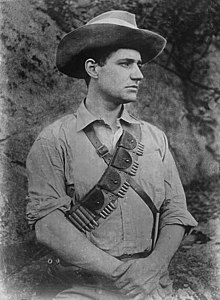Fritz Joubert Duquesne
| Frederick "Fritz" Joubert Duquesne | |
|---|---|

Captain Duquesne, Boer Army picture. ca. 1900
|
|
| Nickname(s) |
The man who killed Kitchener; The Black Panther;The Duke Aliases (ca. 30 known):Captain Claude Stoughton;Frederick Fredericks;Boris Zakrevsky (assumed the identity of the real-life Russian Duke);Major Frederick Craven;George Fordham;Piet Niacud;Colonel Beza |
| Born | 21 September 1877 Cape Colony |
| Died | 24 May 1956 (aged 78) New York City |
| Allegiance | Boer and German |
| Service/branch | primarily Espionage |
| Years of service | 1899–1901 (Boer); 1901 (British); c1913-1942 (German) |
| Rank |
Captain (South Africa) Lieutenant (Britain; infiltrator) Colonel (Germany) |
| Commands held | Duquesne Spy Ring |
| Battles/wars |
— Siege of Ladysmith — Battle of Colenso — Battle of Bergendal — Plot to sabotage Cape Town — Espionage in United States — Sinking of 22 British merchant ships in South America, including: the Tennyson, the Salvador, and the Pembrokeshire — Sinking of the HMS Hampshire (disputed) — Assassination of Lord Kitchener (disputed) — Espionage in United States |
| Awards | Iron Cross, 1916 (disputed) |
| Other work | commando; war correspondent; journalist |
Frederick "Fritz" Joubert Duquesne (/duːˈkeɪn/; 21 September 1877 – 24 May 1956), sometimes Du Quesne, was a South African Boer and German soldier, big-game hunter, journalist, and a spy.
He fought on the side of the Boers in the Second Boer War and as a secret agent for Germany during both World Wars. He gathered human intelligence, led spy rings and carried out sabotage missions as a covert field asset in South Africa, Great Britain, Central and South America, and the United States. He went by many aliases, fictionalized his identity and background on multiple occasions, and operated as a conman. As a Boer spy he was known as the "Black Panther", in World War II he operated under the code name DUNN, and in FBI files he is frequently referred to as "The Duke." He was captured, convicted, and escaped several prisons.
During the Second Boer War, from 1899 to 1902, Duquesne was captured and imprisoned three times by the British and once by the Portuguese, and each time he escaped. On one occasion he infiltrated the British army, became a British officer, and led an attempt to sabotage Cape Town and to assassinate the commander-in-chief Lord Kitchener, only his team was given up by an informant and all were captured and sentenced to death. After a failed attempt to escape prison in Cape Town, he was sent to prison in Bermuda, but he escaped to the United States and became an American citizen. In World War I, he became a spy and ring leader for Germany and during this time he sabotaged British merchant ships in South America with concealed bombs and destroyed several. He sometimes purchased insurance on merchandise he shipped on the vessels he sabotaged and then filed claims for damages. He became known as "the man who killed Kitchener" since he claimed to have guided a German U-boat to sink the HMS Hampshire on which Lord Kitchener was en route to Russia in 1916, although forensics of the ship do not support this claim. After he was caught by federal agents in New York in 1917, he feigned paralysis for two years and cut the bars of his cell to make his escape, thereby avoiding deportation to England where he faced execution for the deaths of British sailors. In 1932, he was again captured in New York by federal agents and charged with both homicide and for being an escaped prisoner, only this time he was set free after Britain declined to pursue the wartime crimes. The last time he was captured and imprisoned was in 1941 when he and 32 other members of the Duquesne Spy Ring were caught by William G. Sebold, a double agent with the FBI, and later convicted in the largest espionage conviction in the history of the United States.
...
Wikipedia
